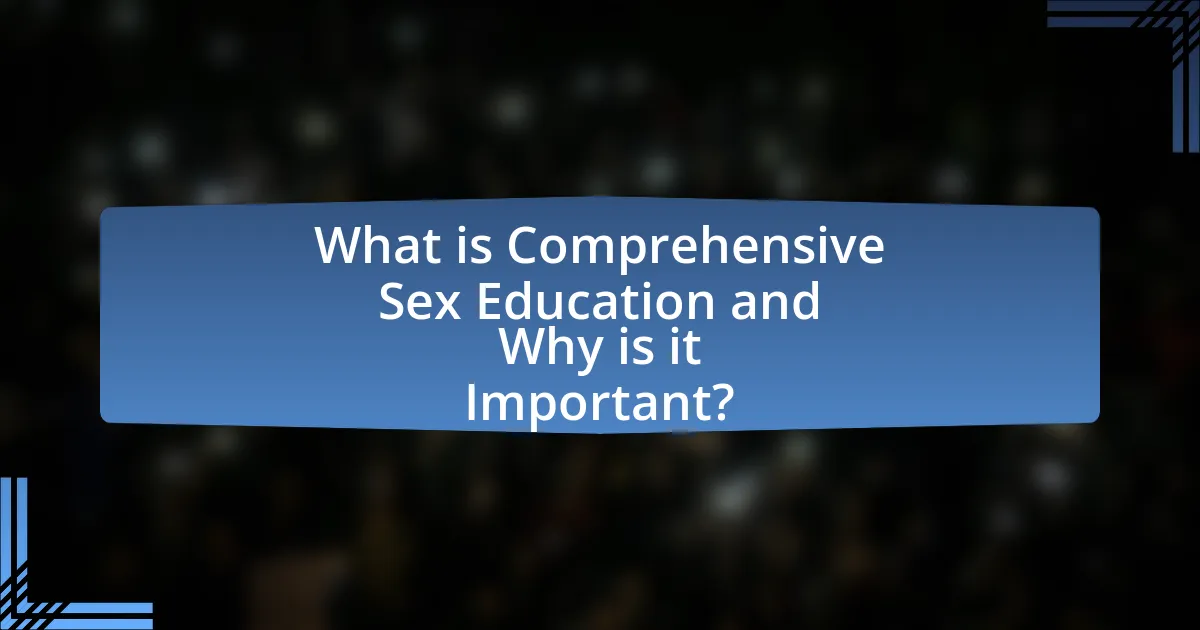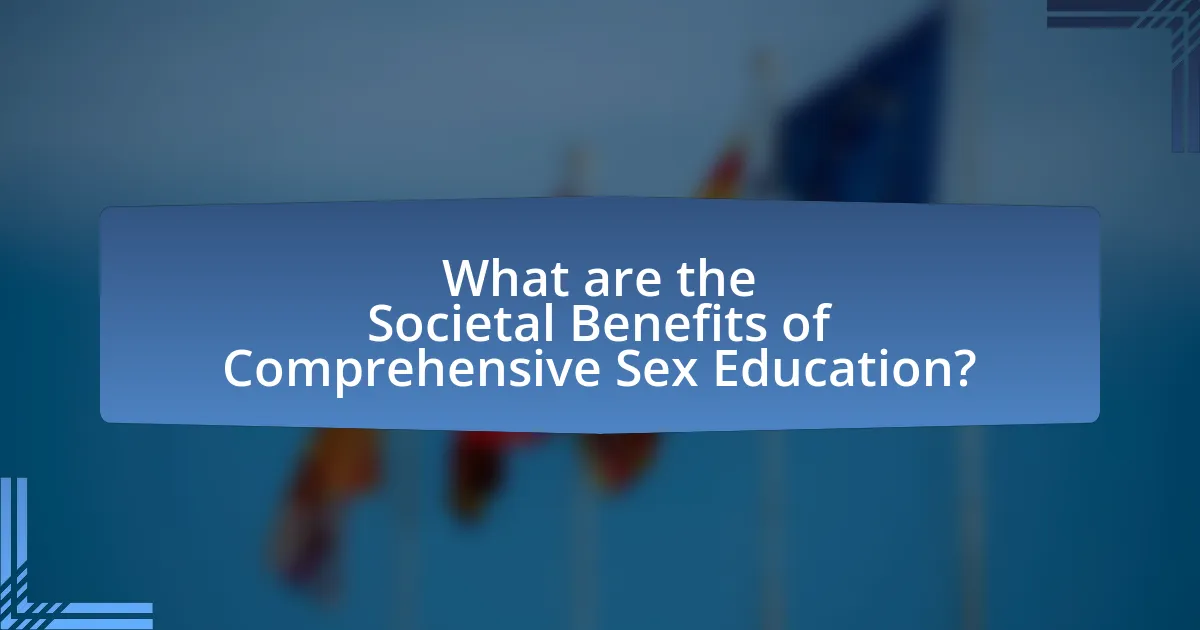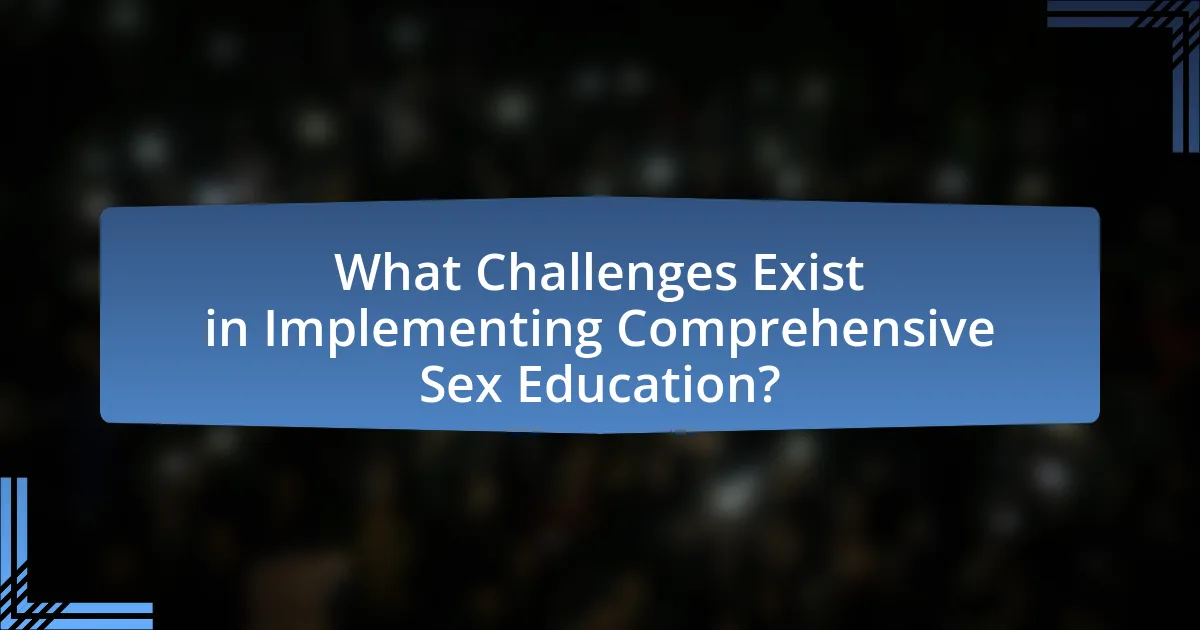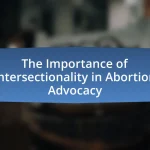Comprehensive Sex Education (CSE) is an educational framework that provides accurate and age-appropriate information about human sexuality, including consent, relationships, reproductive health, and safe sex practices. This approach is crucial in preventing unwanted pregnancies and sexually transmitted infections (STIs), as research shows that CSE can reduce teenage pregnancy rates by up to 50%. The article explores the differences between CSE and traditional sex education, the key topics covered, the societal benefits, and the challenges faced in its implementation. It also addresses common misconceptions and highlights the importance of a holistic approach to sexual health education for empowering young individuals and improving public health outcomes.

What is Comprehensive Sex Education and Why is it Important?
Comprehensive Sex Education (CSE) is an educational approach that provides accurate, age-appropriate information about human sexuality, including topics such as consent, relationships, reproductive health, and safe sex practices. CSE is important because it equips individuals with the knowledge and skills necessary to make informed decisions about their sexual health, thereby reducing the rates of unwanted pregnancies and sexually transmitted infections (STIs). Research indicates that CSE can lead to a significant decrease in teenage pregnancy rates; for instance, a study published in the Journal of Adolescent Health found that comprehensive programs can reduce the likelihood of teenage pregnancy by up to 50%. This evidence underscores the critical role of CSE in promoting healthier outcomes for young people.
How does Comprehensive Sex Education differ from traditional sex education?
Comprehensive Sex Education differs from traditional sex education primarily in its holistic approach to sexual health, encompassing a wide range of topics including consent, relationships, and sexual orientation, rather than focusing solely on the biological aspects of reproduction. Research indicates that comprehensive programs lead to more informed decision-making among adolescents, resulting in lower rates of unintended pregnancies and sexually transmitted infections. For instance, a study published in the Journal of Adolescent Health found that students receiving comprehensive sex education were 50% less likely to experience an unintended pregnancy compared to those who received traditional education.
What key topics are covered in Comprehensive Sex Education?
Comprehensive Sex Education covers key topics such as human anatomy, reproduction, consent, contraception, sexually transmitted infections (STIs), healthy relationships, and sexual orientation. These topics are essential for equipping individuals with the knowledge to make informed decisions regarding their sexual health. Research indicates that comprehensive sex education programs can lead to a reduction in unwanted pregnancies and STIs, as they provide accurate information and promote safe practices. For instance, a study published in the Journal of Adolescent Health found that students who received comprehensive sex education were more likely to use contraception consistently compared to those who did not receive such education.
Why is a holistic approach essential in sex education?
A holistic approach is essential in sex education because it addresses the multifaceted nature of human sexuality, encompassing emotional, social, and physical dimensions. This comprehensive perspective ensures that individuals receive well-rounded information that promotes healthy relationships, consent, and informed decision-making. Research indicates that programs incorporating a holistic framework lead to better outcomes in sexual health, including reduced rates of unwanted pregnancies and sexually transmitted infections. For instance, a study published in the Journal of Adolescent Health found that comprehensive sex education significantly lowers the likelihood of teenage pregnancies compared to abstinence-only programs.
What role does Comprehensive Sex Education play in preventing unwanted pregnancies?
Comprehensive Sex Education plays a crucial role in preventing unwanted pregnancies by equipping individuals with knowledge about reproductive health, contraception, and healthy relationships. Studies show that programs offering comprehensive sex education lead to a significant reduction in teenage pregnancy rates; for instance, a review by the Guttmacher Institute found that comprehensive sex education can reduce the likelihood of teenage pregnancy by up to 50%. This education empowers individuals to make informed decisions regarding their sexual health, understand the importance of consent, and utilize contraceptive methods effectively, thereby decreasing the incidence of unintended pregnancies.
How does knowledge of contraception contribute to pregnancy prevention?
Knowledge of contraception significantly contributes to pregnancy prevention by enabling individuals to make informed choices about their reproductive health. When people understand various contraceptive methods, including their effectiveness and proper usage, they are more likely to use them consistently and correctly. Research indicates that comprehensive sex education, which includes information about contraception, can reduce unintended pregnancies by up to 50% among adolescents. This is supported by data from the Guttmacher Institute, which highlights that access to contraceptive knowledge leads to increased use of effective methods, thereby lowering the rates of unintended pregnancies.
What impact does Comprehensive Sex Education have on adolescent behavior?
Comprehensive Sex Education significantly improves adolescent behavior by equipping young people with knowledge about sexual health, relationships, and consent. Research indicates that adolescents who receive comprehensive sex education are more likely to delay sexual activity, use contraception effectively, and engage in safer sexual practices. For instance, a study published in the Journal of Adolescent Health found that comprehensive sex education programs can reduce the rates of sexually transmitted infections and unintended pregnancies among teenagers by up to 50%. This evidence underscores the effectiveness of such educational programs in fostering responsible decision-making and healthier behaviors among adolescents.

What are the Societal Benefits of Comprehensive Sex Education?
Comprehensive sex education provides significant societal benefits, including reduced rates of unintended pregnancies and sexually transmitted infections (STIs). Research indicates that programs offering comprehensive sex education lead to a 50% reduction in teen pregnancy rates compared to those that do not. Additionally, comprehensive sex education equips individuals with knowledge about consent, healthy relationships, and safe practices, fostering a more informed and responsible society. Studies show that states with comprehensive sex education have lower rates of STIs, demonstrating its effectiveness in promoting public health.
How does Comprehensive Sex Education affect public health outcomes?
Comprehensive Sex Education positively affects public health outcomes by reducing rates of sexually transmitted infections (STIs) and unintended pregnancies. Studies indicate that programs providing comprehensive sex education lead to a 50% reduction in teen pregnancy rates compared to those without such education. For instance, research published in the Journal of Adolescent Health found that adolescents who received comprehensive sex education were more likely to use contraception effectively, thereby decreasing the incidence of STIs and unintended pregnancies. This evidence underscores the critical role of comprehensive sex education in promoting healthier sexual behaviors and improving overall public health.
What statistics support the effectiveness of Comprehensive Sex Education?
Comprehensive Sex Education (CSE) is effective in reducing unwanted pregnancies, as evidenced by various studies. For instance, a meta-analysis published in the Journal of Adolescent Health found that CSE programs can lead to a 50% reduction in the rate of teenage pregnancies. Additionally, research from the Guttmacher Institute indicates that states with CSE curricula have lower rates of teen births compared to those without such programs, with a 30% decrease noted in states that implemented comprehensive education. Furthermore, the National Campaign to Prevent Teen and Unplanned Pregnancy reported that CSE significantly increases the use of contraceptives among adolescents, contributing to a decline in unintended pregnancies. These statistics collectively demonstrate the effectiveness of Comprehensive Sex Education in preventing unwanted pregnancies.
How does Comprehensive Sex Education contribute to reducing STIs?
Comprehensive Sex Education significantly contributes to reducing STIs by equipping individuals with knowledge about safe sexual practices, including the correct use of condoms and the importance of regular testing. Research indicates that programs emphasizing comprehensive sex education lead to a 50% reduction in STIs among adolescents, as they are more likely to engage in safer sexual behaviors. For instance, a study published in the Journal of Adolescent Health found that comprehensive sex education programs resulted in increased condom use and reduced rates of chlamydia and gonorrhea among participants. This evidence underscores the effectiveness of comprehensive sex education in promoting informed decision-making and ultimately lowering STI transmission rates.
What are the long-term benefits of Comprehensive Sex Education for individuals?
Comprehensive Sex Education provides individuals with long-term benefits such as improved sexual health, reduced rates of sexually transmitted infections (STIs), and lower instances of unintended pregnancies. Research indicates that individuals who receive comprehensive sex education are more likely to engage in safer sexual practices, including the consistent use of condoms and other contraceptives. For instance, a study published in the Journal of Adolescent Health found that comprehensive sex education programs can lead to a 50% reduction in teen pregnancy rates compared to those who receive abstinence-only education. Additionally, individuals educated in comprehensive sex education demonstrate greater knowledge about reproductive health, which empowers them to make informed decisions throughout their lives.
How does Comprehensive Sex Education empower young people?
Comprehensive Sex Education empowers young people by providing them with accurate information about sexual health, relationships, and consent, which enhances their decision-making skills. This education equips adolescents with the knowledge to understand their bodies, recognize healthy versus unhealthy relationships, and make informed choices regarding their sexual health. Research indicates that comprehensive sex education programs lead to a reduction in rates of unintended pregnancies and sexually transmitted infections among youth, as evidenced by a study published in the Journal of Adolescent Health, which found that students who received comprehensive sex education were 50% less likely to experience an unintended pregnancy compared to those who did not receive such education.
What skills do individuals gain from Comprehensive Sex Education?
Individuals gain critical skills from Comprehensive Sex Education, including knowledge of reproductive health, communication skills, and decision-making abilities. This education equips individuals with accurate information about human anatomy, contraception, and sexually transmitted infections, enabling informed choices regarding sexual health. Furthermore, it fosters effective communication skills, allowing individuals to discuss consent and boundaries openly. Research indicates that comprehensive sex education programs lead to healthier sexual behaviors and reduced rates of unintended pregnancies, as evidenced by studies showing a 50% decrease in teen pregnancy rates in areas with such programs compared to those without.

What Challenges Exist in Implementing Comprehensive Sex Education?
Implementing comprehensive sex education faces several challenges, including cultural resistance, lack of funding, and insufficient training for educators. Cultural resistance often stems from differing beliefs about sexuality, which can lead to pushback from parents and community groups. Lack of funding limits the development and distribution of effective curricula, while insufficient training for educators can result in inconsistent delivery of the material. According to a 2018 report by the Guttmacher Institute, only 22 states and the District of Columbia mandate sex education, highlighting the variability in implementation across the United States. These factors collectively hinder the effectiveness of comprehensive sex education in preventing unwanted pregnancies.
What are the common misconceptions about Comprehensive Sex Education?
Common misconceptions about Comprehensive Sex Education include the belief that it encourages sexual activity among youth, that it is solely about teaching about contraception, and that it is inappropriate for younger students. Research indicates that comprehensive sex education does not increase sexual activity; in fact, studies show that it can lead to delayed sexual initiation and reduced rates of unintended pregnancies and sexually transmitted infections. Additionally, comprehensive sex education encompasses a wide range of topics, including healthy relationships, consent, and emotional aspects of sexuality, rather than focusing exclusively on contraception. Furthermore, age-appropriate comprehensive sex education is designed to be suitable for younger students, addressing their developmental needs and providing them with essential knowledge to make informed decisions.
How do cultural beliefs impact the acceptance of Comprehensive Sex Education?
Cultural beliefs significantly influence the acceptance of Comprehensive Sex Education (CSE) by shaping attitudes towards sexuality and education. For instance, in cultures where conservative values dominate, there may be resistance to CSE due to beliefs that prioritize abstinence or view discussions about sex as taboo. Research indicates that communities with strong religious affiliations often oppose CSE, believing it contradicts their moral teachings. A study published in the Journal of Adolescent Health found that areas with high levels of religious conservatism had lower rates of CSE implementation, correlating with higher rates of unintended pregnancies. Thus, cultural beliefs directly affect the willingness to adopt CSE, impacting public health outcomes.
What resistance do educators face when teaching Comprehensive Sex Education?
Educators face significant resistance when teaching Comprehensive Sex Education due to cultural, political, and parental opposition. Many parents and community members express concerns that such education may encourage sexual activity among adolescents, despite research indicating that comprehensive programs can lead to healthier behaviors. Additionally, some political entities advocate for abstinence-only education, which limits the scope of information provided to students. Studies, such as those published by the Guttmacher Institute, show that comprehensive sex education is more effective in reducing unwanted pregnancies and sexually transmitted infections compared to abstinence-only approaches.
How can these challenges be overcome to improve Comprehensive Sex Education?
To overcome challenges in Comprehensive Sex Education (CSE), it is essential to implement evidence-based curricula that address diverse needs and perspectives. Research indicates that inclusive and culturally relevant programs significantly enhance student engagement and understanding, leading to better outcomes in sexual health. For instance, the National Sexuality Education Standards emphasize the importance of age-appropriate, medically accurate information, which has been shown to reduce rates of unintended pregnancies and sexually transmitted infections. Additionally, training educators to deliver CSE effectively can mitigate resistance from parents and communities, as demonstrated by programs that involve stakeholders in the curriculum development process. By fostering collaboration among educators, parents, and health professionals, CSE can be tailored to meet the specific needs of students, ultimately improving its effectiveness in preventing unwanted pregnancies.
What strategies can be employed to advocate for Comprehensive Sex Education?
To advocate for Comprehensive Sex Education, stakeholders can employ strategies such as building coalitions with educators, parents, and health professionals to create a unified voice for policy change. Research indicates that states with comprehensive sex education programs experience lower rates of teenage pregnancies; for instance, a study by the Guttmacher Institute found that comprehensive programs can reduce teen pregnancy rates by up to 50%. Engaging in community outreach and awareness campaigns can also help inform the public about the benefits of comprehensive sex education, thereby increasing support for its implementation in schools. Additionally, leveraging social media platforms to share success stories and data can mobilize grassroots support and influence policymakers.
How can parents and communities support Comprehensive Sex Education initiatives?
Parents and communities can support Comprehensive Sex Education (CSE) initiatives by advocating for inclusive curricula in schools and participating in local educational boards. Research indicates that comprehensive sex education significantly reduces rates of unwanted pregnancies and sexually transmitted infections among adolescents. For instance, a study published in the Journal of Adolescent Health found that students who received CSE were 50% less likely to experience an unintended pregnancy compared to those who did not. By engaging in discussions, attending school meetings, and collaborating with educators, parents and community members can ensure that CSE is prioritized and effectively implemented, ultimately contributing to healthier outcomes for youth.
What are practical steps for implementing Comprehensive Sex Education effectively?
To implement Comprehensive Sex Education effectively, educational institutions should adopt a curriculum that is age-appropriate, culturally relevant, and medically accurate. This involves training educators to deliver the content confidently and ensuring that the curriculum includes topics such as consent, healthy relationships, and contraception methods. Research indicates that comprehensive sex education can lead to a reduction in unwanted pregnancies; for instance, a study published in the Journal of Adolescent Health found that students who received comprehensive sex education were 50% less likely to experience an unintended pregnancy compared to those who did not. Additionally, engaging parents and communities in the development and delivery of the program fosters support and enhances its effectiveness.
How can educators create an inclusive and safe learning environment?
Educators can create an inclusive and safe learning environment by implementing policies that promote respect, understanding, and support for all students. This includes establishing clear anti-bullying policies, fostering open communication, and providing training on diversity and inclusion for staff. Research indicates that inclusive environments lead to better academic outcomes; for instance, a study published in the Journal of Educational Psychology found that students in inclusive classrooms reported higher levels of engagement and lower levels of anxiety. Additionally, creating safe spaces for discussions about sensitive topics, such as sexual health, can empower students to express themselves without fear of judgment, further enhancing their learning experience.
What resources are available for teaching Comprehensive Sex Education?
Comprehensive Sex Education can be taught using various resources, including curricula developed by organizations such as the Sexuality Information and Education Council of the United States (SIECUS) and the American Sexual Health Association (ASHA). These organizations provide evidence-based materials that cover topics like consent, contraception, and sexually transmitted infections. Additionally, the Centers for Disease Control and Prevention (CDC) offers guidelines and resources for educators to implement effective sex education programs. Research indicates that comprehensive sex education reduces rates of unintended pregnancies and sexually transmitted infections, supporting the effectiveness of these resources in educational settings.


